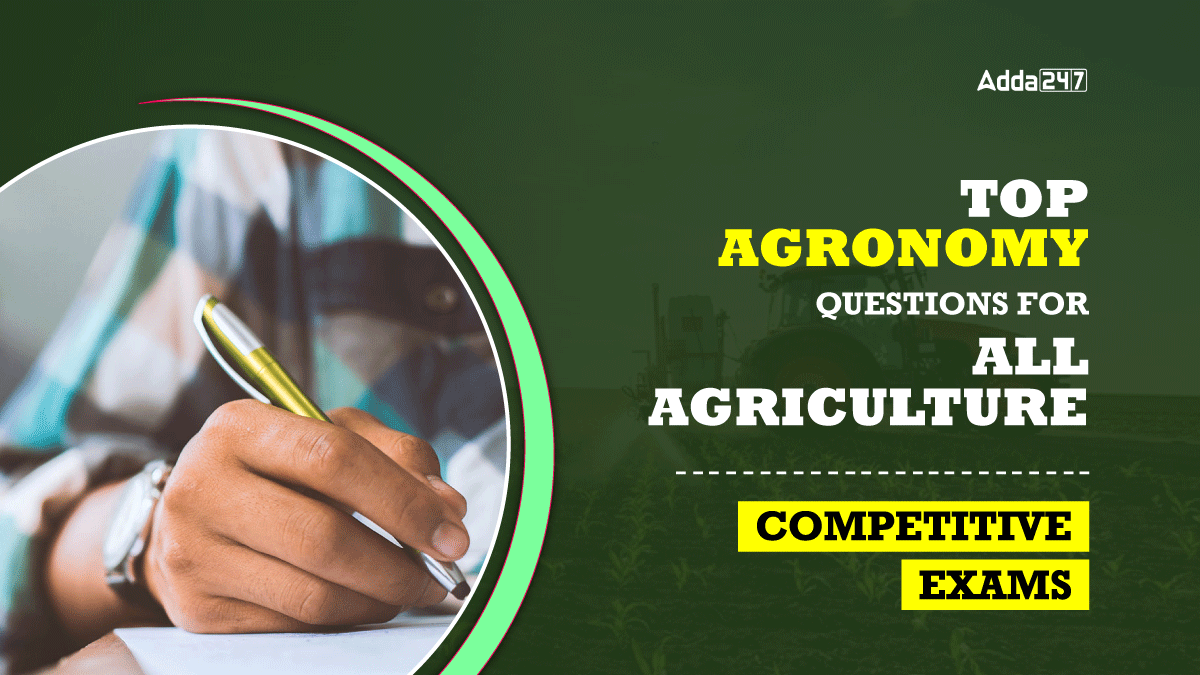When preparing for agriculture competitive exams, it’s important to focus on key agronomy questions that cover basic concepts. Topics like soil management, crop rotation, plant growth, and sustainable farming practices often appear in these exams. Understanding how to manage pests, use irrigation effectively, and consider the impact of weather on crops is crucial. By mastering these topics, students can boost their knowledge and improve their chances of success in agriculture-related exams.
Top Agronomy Questions
If you’re looking for important agronomy questions for your exam preparation, you’ve come to the right place. In this article, we provide essential agronomy questions along with solutions to help sharpen your skills and enhance your understanding of key concepts.
Agronomy Questions with Answers
Q1. What is the main purpose of Beushiening in rice cultivation?
(a) Improve soil fertility
(b) Increase water retention
(c) Control weeds, optimize crop stand, and aeration
(d) Reduce pest infestation
(e) Enhance seed germination
S1. Ans: (c)
Sol. Beushiening is primarily done to control weeds, optimize the crop stand, and improve soil aeration, which promotes better growth and health of the rice plants.
Q2. What is the main objective of puddling in rice fields?
(a) Improve soil fertility
(b) Reduce percolation losses of water
(c) Increase soil temperature
(d) Enhance water retention
(e) Promote root elongation
S2. Ans: (b)
Sol. The main objective of puddling is to reduce the percolation losses of water, which is crucial for maintaining water availability in rice fields.
Q3. What is the primary effect of puddling on soil structure?
(a) Enhances root penetration
(b) Increases soil aeration
(c) Destroys soil aggregates
(d) Reduces soil bulk density
(e) Promotes nutrient fixation
S3. Ans: (c)
Sol. Puddling involves the destruction of soil aggregates by mechanical force in soils with excessive moisture content, which hampers root penetration and affects the development of future crops.
Q4. Who developed the System of Rice Intensification (SRI) methodology?
(a) Norman Borlaug in Mexico
(b) M.S. Swaminathan in India
(c) Henri de Laulanie in Madagascar
(d) Robert H. Burris in the USA
(e) Fritz Haber in Germany
S4. Ans: (c)
Sol. The System of Rice Intensification (SRI) was developed by Henri de Laulanie in Madagascar during the 1980s. It is an agroecological approach aimed at improving the productivity of irrigated rice by changing the management of plants, soil, water, and nutrients while promoting organic farming practices.
Q5. Which of the following is a core principle of the System of Rice Intensification (SRI)?
(a) Increase plant density, maximize irrigation
(b) Use chemical fertilizers, herbicides
(c) Reduce plant density, minimize irrigation
(d) Maximize herbicides, compact soil
(e) Increase water usage
S5. Ans: (c)
Sol. The core principles of SRI include reducing plant population density, minimizing irrigation, and improving soil conditions with minimal or no use of herbicides and chemicals. This methodology promotes sustainable rice cultivation with enhanced productivity and reduced environmental impact.
Q6. During which process are the aleurone layer and embryo removed from rice grain?
(a) Threshing
(b) Harvesting
(c) Milling
(d) Winnowing
(e) Drying
S6. Ans: (c)
Sol. Milling is the process where the aleurone layer and embryo are removed from the rice grain during polishing. This leads to the loss of vitamin B, particularly thiamine, which can cause the disease ‘beri-beri’ in people who consume polished rice regularly.
Q7. What is the main process that occurs during the parboiling of rice?
(a) Removal of the aleurone layer
(b) Crystallization of starch
(c) Conversion of starch into an amorphous form
(d) Drying of rice grain
(e) Extraction of proteins
S7. Ans: (c)
Sol. Parboiling is a hydrothermal process where the crystalline form of starch is changed into an amorphous form due to irreversible swelling and fusion of starch. This process improves the quality of rice by making it more durable and less prone to breaking during milling.
Q8. In wheat cultivation, which seed-sowing method involves dropping seeds by hand into furrows made by a country plough?
(a) Dibbling method
(b) Broadcasting method
(c) Kera method
(d) Drilling method
(e) Transplanting method
S8. Ans: (c)
Sol. The Kera method involves dropping seeds by hand into furrows made by a country plough. This is a traditional seed sowing method used in wheat cultivation where the seeds are manually placed into prepared furrows.
Q9. Maize protein, called ‘zein’, is deficient in which of the following amino acids?
(a) Methionine and leucine
(b) Tryptophan and lysine
(c) Alanine and glycine
(d) Valine and isoleucine
(e) Serine and threonine
S9. Ans: (b)
Sol. The main protein in maize, ‘zein’, is deficient in two essential amino acids, tryptophan, and lysine. This deficiency limits its nutritional quality, especially for human consumption, as these amino acids are vital for proper growth and metabolism.
Q10. Which disease results from a deficiency of niacin and tryptophan in maize-based diets?
(a) Beri-beri
(b) Pellagra
(c) Scurvy
(d) Rickets
(e) Kwashiorkor
S10. Ans: (b)
Sol. Pellagra is caused by a deficiency of niacin (vitamin B3) and tryptophan, often seen in individuals who rely heavily on maize, which is low in these essential nutrients. Symptoms include dermatitis, diarrhea, and dementia.
Q11. What is the name of the terminal male flower cluster in maize that bears pollen?
(a) Silk
(b) Tassel
(c) Panicle
(d) Spikelet
(e) Glume
S11. Ans: (b)
Sol. The terminal male flower cluster in maize is called a tassel. It is a branched panicle that bears pollen, which is responsible for fertilizing the female parts of the plant.
Q12. In sorghum, the inflorescence is characterized by which type of panicle?
(a) Spikes
(b) Umbels
(c) Heads
(d) Racemes
(e) Spadix
S12. Ans: (c)
Sol. In sorghum, the inflorescence is a panicle known as the head, which consists of multiple branches bearing small clusters of flowers, aiding in the plant’s reproductive process.
Q13. What is the inflorescence of sugarcane called, characterized as an open-branched panicle?
(a) Spikelet
(b) Arrow
(c) Raceme
(d) Umbel
(e) Spadix
S13. Ans: (b)
Sol. The inflorescence of sugarcane is known as an “Arrow,” which is an open-branched panicle. This structure is vital for the reproduction of sugarcane as it holds the flowers responsible for seed production.
Q14. In which crop is blind hoeing an important practice for weed control before crop emergence?
(a) Wheat
(b) Maize
(c) Sugarcane
(d) Rice
(e) Cotton
S14. Ans: (c)
Sol. Blind hoeing is a significant practice in sugarcane cultivation, where it is performed after planting and before the crop emerges to control weeds effectively, promoting better growth and reducing competition for nutrients.
Q15. What is the purpose of the nipping and topping practice in gram cultivation?
(a) To improve root growth
(b) To increase water retention in soil
(c) To enhance vegetative growth
(d) To encourage reproductive growth
(e) To control pest infestation
S15. Ans: (d)
Sol. Nipping and topping in gram cultivation involve pruning the top branches of the plant to encourage reproductive growth. This practice helps in promoting the development of more flowers and pods, leading to increased yields.
Q16. Delinting/deffusing is a seed management technique commonly used for which crop?
(a) Wheat
(b) Rice
(c) Cotton
(d) Maize
(e) Sorghum
S16. Ans: (c)
Sol. Delinting/deffusing is a seed management technique commonly used for cotton seeds, where concentrated sulphuric acid (in a ratio of 1:10) is used to remove lint, making the seeds easier to grade, improving germination, and helping to kill hibernating insects and destroy pathogens.
Q17. What is the process of separating fiber from seed cotton called?
(a) Spinning
(b) Weaving
(c) Ginning
(d) Carding
(e) Baling
S17. Ans: (c)
Sol. Ginning is the process of separating fiber from seed cotton. The typical ginning percentage for cotton ranges between 30-35%. This process is crucial in preparing cotton for further processing into textiles.
Q18. What does the ribboning process in jute cultivation involve?
(a) Retting whole plants
(b) Peeling bark and retting ribbons
(c) Soaking fibers in chemicals
(d) Cutting plants for fodder
(e) Separating seeds from fibers
S18. Ans: (b)
Sol. Ribboning in jute cultivation involves peeling the raw bark from the green plant immediately after harvest. The ribbons obtained are then retted to extract the fibers, allowing for faster retting compared to traditional methods.
Q19. What is the microbial process called where aerobic and anaerobic bacteria and fungi loosen the fiber by decomposing pectin, hemicelluloses, and other cementing agents?
(a) Ginning
(b) Retting
(c) Decortication
(d) Scutching
(e) Combing
S19. Ans: (b)
Sol. Retting is the microbial process in which aerobic and anaerobic bacteria, along with fungi, decompose and dissolve pectin, hemicelluloses, and other cementing agents, loosening the fiber. This process typically takes 8-30 days and is vital in fiber extraction from plants like jute and flax. The optimum temperature required for retting is about 34°C (rostochinensis).
Q20. What is the process called when the capsule protecting sesame seeds bursts upon seed ripening?
(a) Abscission
(b) Dehiscence
(c) Germination
(d) Pollination
(e) Parthenogenesis
S20. Ans: (b)
Sol. Dehiscence is the process where the capsule surrounding sesame seeds bursts open when the seeds are completely ripe. This ensures seed dispersal at the appropriate stage of maturity.
Q21. What is the inflorescence of Sesamum indicum (sesame) commonly known as?
(a) Umbel
(b) Spike
(c) Panicle
(d) Raceme
(e) Corymb
S21. Ans: (d)
Sol. The inflorescence of Sesamum indicum (sesame) is known as a raceme, which is a type of flower arrangement where flowers are attached by short stalks along a central axis. This is typical in plants like sesame.
Q22. What is the inflorescence of Helianthus annuus called?
(a) Spike
(b) Raceme
(c) Capitulum
(d) Corymb
(e) Panicle
S22. Ans: (c)
Sol. The inflorescence of Helianthus annuus (sunflower) is called a capitulum, which is a disk-like flower head consisting of numerous small flowers (florets) arranged closely together, typical of plants in the Asteraceae family.
Q23. What does the process of priming in tobacco cultivation involve?
(a) Removal of young leaves
(b) Removal of matured leaves
(c) Application of fertilizers
(d) Harvesting the entire plant
(e) Drying the leaves
S23. Ans: (b)
Sol. Priming in tobacco refers to the removal of matured leaves. The entire harvest typically requires 5-6 rounds of priming, and the harvested leaves are primarily used in cigarette and wrapper tobacco production. This process ensures that only mature, high-quality leaves are selected for use.
Q24. What is the process called in which harvested tobacco leaves are dried to make them ready for the market?
(a) Priming
(b) Ginning
(c) Curing
(d) Fermentation
(e) Retting
S24. Ans: (c)
Sol. Curing is the process by which the harvested tobacco leaf is dried and made ready for the market. During curing, most of the moisture is removed from the leaves, imparting the required color, texture, and aroma to the final product. For example, flue curing is used in the production of cigarette tobacco.
Q25. What is the fruit type of Carthamus tinctorius (Safflower)?
(a) Capsule
(b) Drupe
(c) Achene
(d) Berry
(e) Nut
S25. Ans: (c)
Sol. The fruit of Carthamus tinctorius (Safflower) is an achene, which is a small, dry, single-seeded fruit that does not open to release the seed. This type of fruit is typical for plants in the Asteraceae family.



 TPSC FSO Exam Date Out, Check Tentative ...
TPSC FSO Exam Date Out, Check Tentative ...
 MP Food Safety Officer Previous Year Que...
MP Food Safety Officer Previous Year Que...
 MP FSO Syllabus 2025, Check Exam Pattern
MP FSO Syllabus 2025, Check Exam Pattern




 Adda247 Job portal has complete information about all Sarkari Jobs and Naukri Alerts, its latest recruitment notifications, from all state and national level jobs and their updates.
Adda247 Job portal has complete information about all Sarkari Jobs and Naukri Alerts, its latest recruitment notifications, from all state and national level jobs and their updates.



